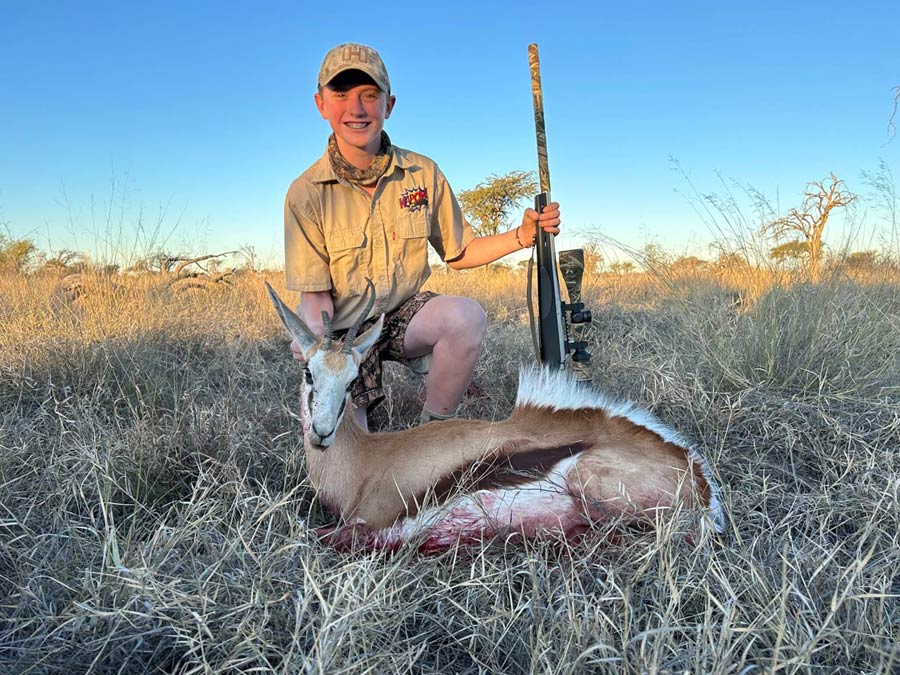Being born and bred in South Africa, I have been privileged to participate in many game hunting safaris. The opportunity to hunt African plains game in the Kalahari, together with my brothers, was an opportunity I could not let slip through my fingers!
[DYNAMIC-BLOGTABLEOFCONTENT]
The Kalahari at a Glance
What is the best species to target on a hunting safari in the Kalahari?
The Kalahari Desert stretches over South Africa, Botswana, and Namibia and is 350, 000 square miles. The Kalahari is home to dozens of species, ranging from steenbok, impala, and waterbuck, to the common eland and even African big game such as lions and buffalo. With so many options at a person’s disposal, the decision of which animal to target becomes a challenge in itself and reinforces the fact that the area has some of the best game hunting in Africa.
Even though there is a large variety of animals in the Kalahari, the springbok, gemsbok, kudu, red hartebeest, and Burchell’s zebra seem to be crowd favorites when African plains game hunting in South Africa. All these species offer exhilarating hunting experiences, and each species has its unique hunting challenges when game hunting in Africa.
Hunting Methods on an African Hunt in the Kalahari
The methods used on each game hunting safari will vary on what best suits the hunter and his choices. Here can be a more relaxed approach to hunting, where a hunter can target the game from a blind set up near water sources, or drive the open plains glassing for game. Hunters can also opt to walk and get close enough to their targets without spooking them, to make that perfect shot. This is what makes South African plains game hunting very special and challenging at times, and your decisions can make or break your hunt!
What Is the climate and conditions of the Kalahari Desert?
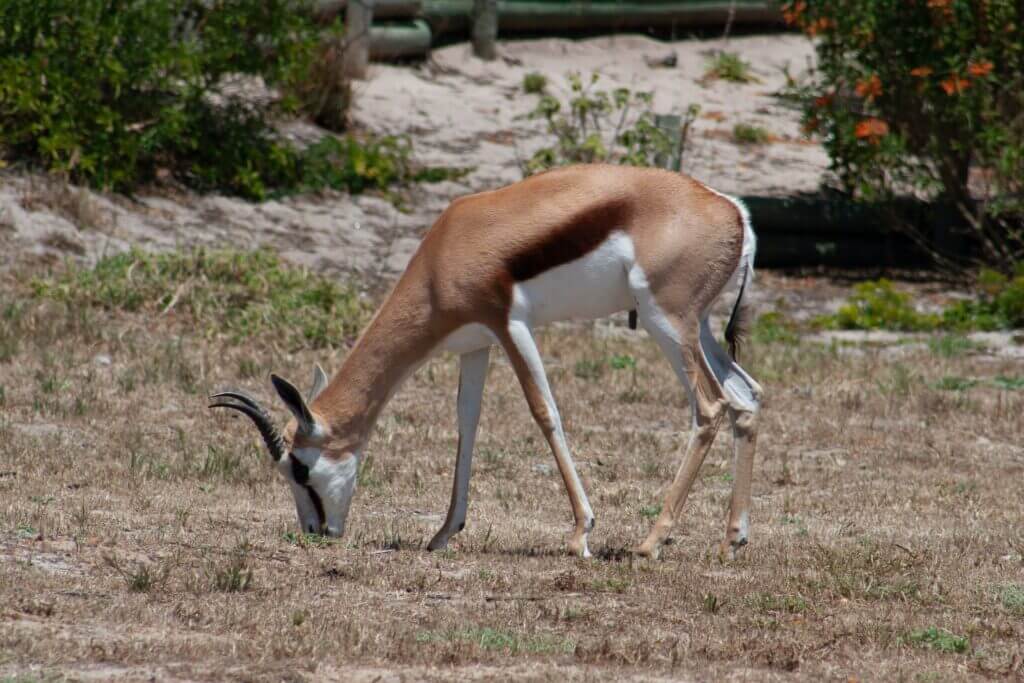
- The Kalahari Desert experiences extreme temperature fluctuations. In summer, temperatures can range from 110-115°F, reaching temperatures as low as 10°F in the winter.
- The weather may be deceiving, starting chilly, and by midday, you are sweating and peeling off the layers, even in winter!
- The Kalahari Desert is a semi-arid (desert and grassland), experiencing its dry season annually from April to September.
- The soils in the desert are largely sand-based and will have little nutrition and are very dry. The sand in the desert is a reddish color due to a thin layer of iron oxide covering the grains of sand.
What to Remember when Game Hunting in the Kalahari
Rifles and Shot Placement
- A general rule on a broadside shot Is 1/3 of the way up on the shoulder.
This allows the hunter to get a heart shot on an animal, and if the shot misses the heart, it will still be a double lung shot with good penetration. - The caliber of the rifle will depend on the size of the target animal, you cannot take a higher caliber rifle for a smaller animal and still have bad shot placement.
- Anything in the 30-calibre range or a little lower will work perfectly with the correct shot placement.
- For big game hunting in South Africa, a higher caliber rifle is recommended, like a 375 for a lion or larger animal.
Plains Game Bow Hunting Rules and Specs
- If a hunter wants to hunt in the Kalahari, they can hunt in South Africa, with a hunting safari in the Northern Cape, or booking a game hunting safari in Botswana.
- Hunting in South Africa and Botswana using a bow is legal, but you need to select a safari that allows for bow hunting.
- For plains game such as kudu, springbok, and warthog, it requires a minimum draw weight of 40 pounds and a 14-ounce minimum arrow weight.
- For larger African plains game antelope such as the wildebeest, gemsbok, and eland, it requires a minimum draw weight of 70 pounds and a 15-ounce arrow.
When is the Best time to book a Kalahari Hunting Safari?
The best time to book an African hunt in the Kalahari Desert is during autumn, winter, and spring, from the beginning of May to the end of September. Summer temperatures in the desert peak at extremely high temperatures, causing some animal species to rest and sleep during the hot weather, and this makes an African plains game hunting trip rather challenging!
Are there activities for non-hunters in the Kalahari?
There are not many options in which non-hunters can participate while the hunting members of their party are on their African hunt. They can relax and enjoy the amenities in the camp, as provided by the local outfitter, or accompany their family member on the hunt at an extra fee. The actual hunting side of things only plays a small part in the overall experience, a non-hunter is able to admire the beauty of nature, the South African plains game, and experience the excitement of a hunting safari.
My African Plains Game Hunt in the Kalahari
Game Hunting Day 1
I am sure other hunters will agree with me: The suspense before any hunt will keep you up at night, there is always plenty of excitement that takes over. It is constant tossing and turning while trying to sleep, but it usually ends up in a long morning ahead. My father and two brothers (Keenan and Slade) started the long journey from Pretoria to the Kalahari at around 02h00, with hot coffee, energy drinks, and a feeling of intense excitement as we pondered over our African hunt ahead!
The weather was extremely chilly, being the middle of winter in the southern hemisphere, and we had layer upon layer of clothes keeping us snug and warm. These layers were tossed aside one by one as dawn broke, the weather warmed, and Africa showed its splendor with some gorgeous winter sunshine.
After what felt like forever, including stopping a few times either to get fuel or to grab a quick snack, we made it to the ranch for our African plains game trip. We arrived at the spot where we were staying. We wanted to enjoy a full hunting experience, without the luxuries often included on a trip, and our camp consisted of tents, a toilet, and a fireplace. We roughed it, and we loved it!
On the first day of our African hunt, I shot a springbok ewe. Following the loud shot of the 3006, she dropped right in her tracks. A few hours later, we added another springbok to the pot, but this time we spotted a ram. My brother, Slade, took the lead on this one, but as he got into position, he couldn’t get a shot on the animal, whereas I had a clear shot. Once again, the 3006 had gone off, this time the springbok had not dropped on the spot. After walking to the target spot, we continued to walk for about 30 yards and found him.
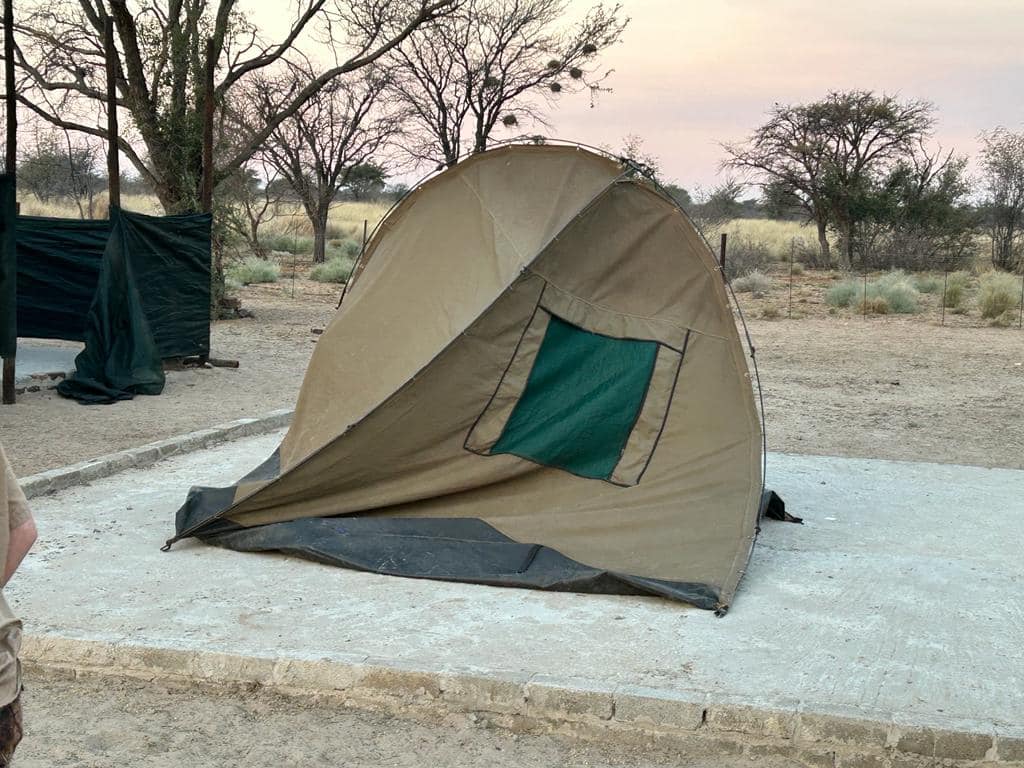
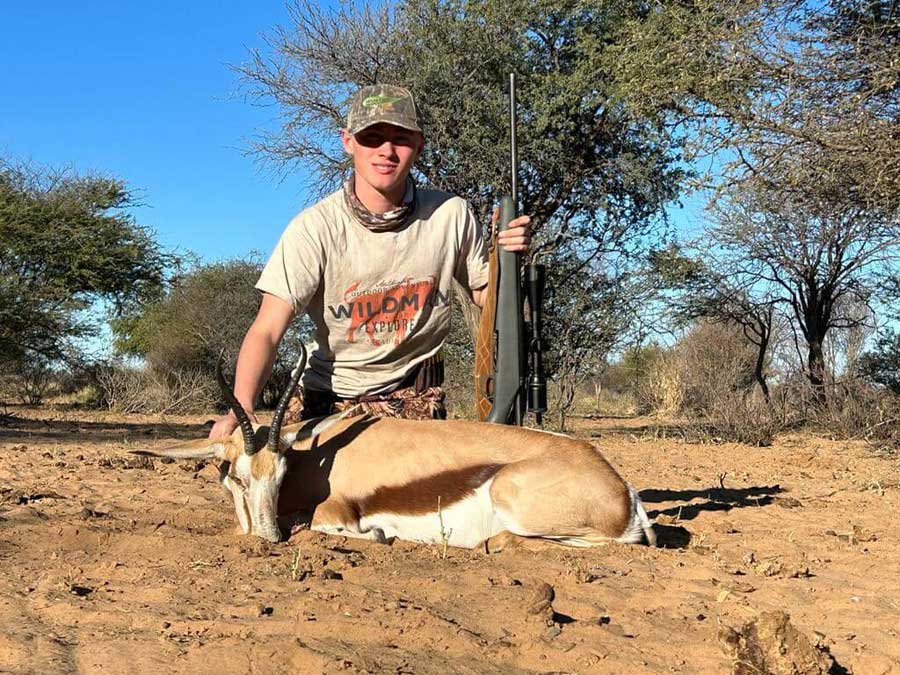
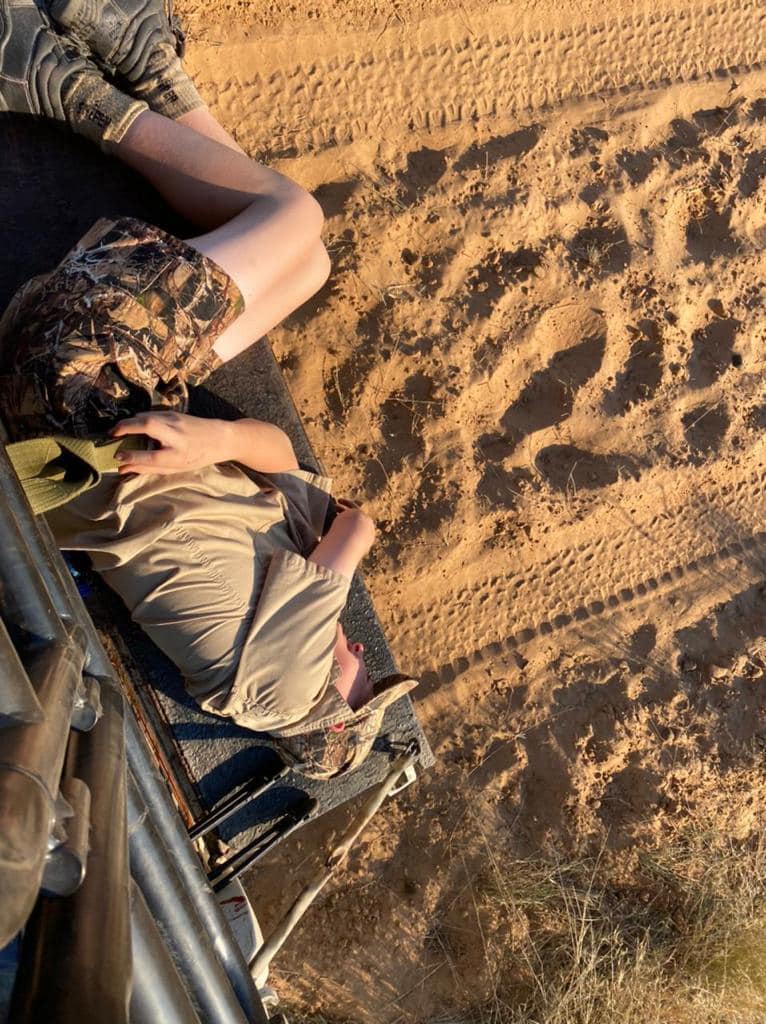
Game Hunting Day 2
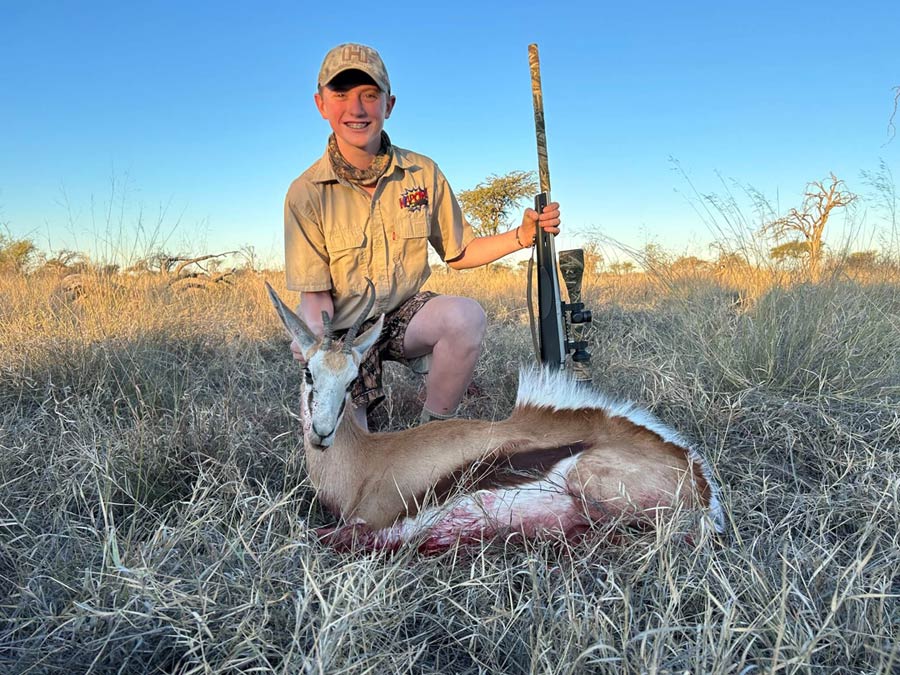
Game Hunting Day 3
Game Hunting Day 4
On the final day of our hunting safari, we returned to the fateful spot where I shot the gemsbok, hoping to find blood or retrieve the wounded animal. We found nothing at all. I decided not to do any hunting for the rest of the day. However, even though things may go wrong for one hunter, it doesn’t mean the remainder of the hunting party should abandon the hunt.
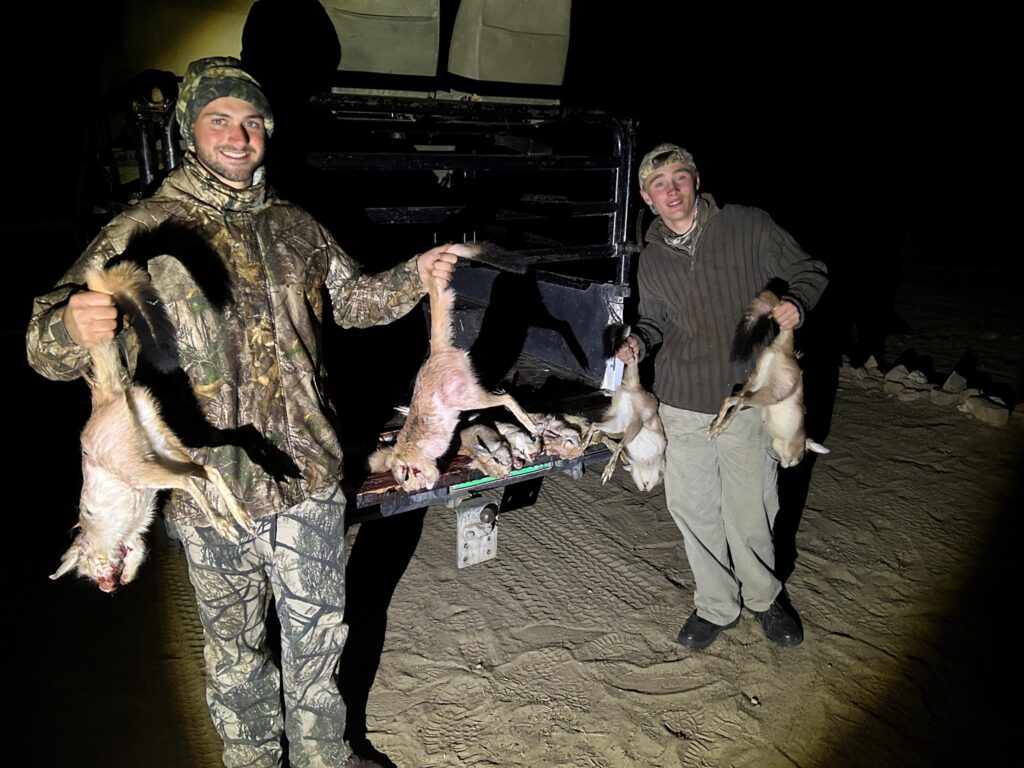
Plenty of warthogs were shot throughout the day. These animals are seen as vermin as they break through fences, dig up water pipes, and are generally very destructive. Warthogs are always exciting to hunt as they usually don’t present a very long window of opportunity! If they do stand still, it will usually be for around two seconds at most and otherwise must be hunted while they are running, which is challenging as they are remarkably fast creatures.
Slade harvested an extremely nice duiker and steenbok. Just before sunset, Keenan loaded a kudu bull, and just like that, our trailer was full! The bush is always active during the last hour of light in the day as it is cooler, and the animals are more active feeding and moving around. This time of the day is often referred to as the “golden hour” as this is when you will probably come across the most animals and have the best opportunities to gather your trophy when plains game hunting in South Africa.
The day shift of hunting might have been over, but the night was still young! We decided to hunt springhare; a small, nocturnal, and burrowing rodent that hops around during the night that feeds on stems, sprouts, herbs, and fruit.
The traditional way of hunting these creatures is chasing after them, using your hands and firm sticks to hunt them. However, they are hunted using shotguns or smaller caliber rifles such as a .22, or even some pellet guns. We used both hunting techniques, hunting some with a shotgun and some on foot. Hunting springhares is always loads of fun, and even if you aren’t successful, spending time hunting them with the people around you is always great fun. We were lucky, and managed to hunt 12 in less than an hour.
The Kalahari Never Disappoints!
To experience an African plains game hunting safari in the Kalahari is worth every cent you may spend! You will have the opportunity to hunt abundant wildlife, under African skies, using a numerous methods and targeting various animals, as per your wish list.
A trip to the Kalahari Desert for hunting in South Africa is certainly one a hunter will forever enjoy and remember. From breathtaking sunrises and sunsets to an amazing array of wildlife, together with the opportunity to experience Africa at its best, there truly is something for everyone on an African hunt. The Kalahari Desert definitely doesn’t disappoint!
If you would like to experience game hunting in Africa at its best, contact us for further information about hunting packages, or let us custom-make a hunt, with your specific requirements in mind!
